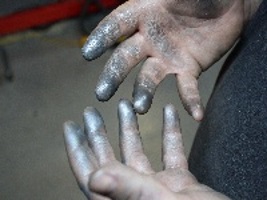How to apply Pinewood Derby Graphite Dry Lube
How to apply Pinewood Derby Graphite Dry Lube is so easy, you can leave it in the hands of your cubber no matter what the age. What important to note is correct rotation of wheels in the forward direction as if the car was traveling down the back. If no treadmill is available, then you can substitute with finger rolling. Just take like 30 minutes per wheel. YES 30 mins per wheel. If mechanical means of rotating wheels is desired or setup, please keep rpms low. NO Dremel or High Speed Rotary Tools!
JUST FOR THE RECORD…. How to apply Pinewood Derby Graphite Dry Lube Things will get dirty. Yes. If you want a fast car lubed with graphite. Then it will be dirty. I promise you this. HOWEVER….. Take a paper towel. Spray / coat a little OLIVE OIL on it then wipe your car. Might get majority of it off. WD-40 also does the trick, but I have found that it will probably remove your clear coat or possible strip away a matte finish paint.
Break in:
Once tuning is complete and you are happy with the wheel play, then it is time to start building up layers of dry lube. Turn the treadmill to full blast! Add a LIBERAL amount of dry lube to all running wheels as it is traveling every 45-60 seconds. Continue this process for 10 minutes. 10 minutes at top speed should yield the equivalent of approximately 400-500 races.
This process will also yield the 20-30 second spin benchmark theory for FULL WEIGHT WHEELS. Reduced weight wheels do not carry enough mass to spin for this amount of time. If you have a wheel that is not performing this well, it could possibly be that it is out of balance or has a warped inner hub due to cooling during manufacturing. Replace it and start process over from beginning (SORRY!) If you want the best, then this is what has to be done.
That’s it your done!
If satisfied PACK your car up in a racing box, and do nothing with it until race day. No other lubing is necessary. We have not seen any data that shows any additional lube after this point helps.
What you have done by doing this process is used the cars weight under load to “roll” multiple layers of lube on the axle and wheel. You have also tuned your car to eliminate fish-tailing and gain greater speeds for your derby car way beyond a simple dust/ finger roll job. It does build layers of near friction-less surface on both the axles and inner wheel hubs that is good for many races.
This process is very hard to describe with words, and our video will show you how simple it really is.


Leave A Comment